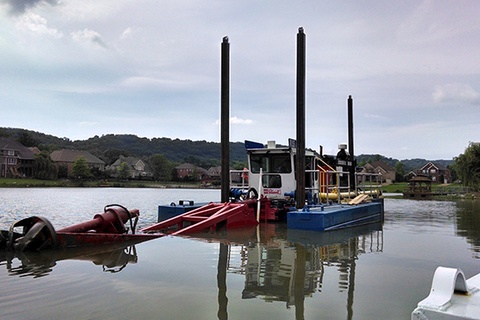

The operator may have to add water to the pond if the dredging process does not return water back into the same pond or lagoon. The dredge then pumps the slurry, a mixture of sludge and water, through pipeline which is usually 6”, 8”, or 10” in diameter for most projects. An auger cutterhead is ideal for making wide passes through the biosolids and transferring them into the pump. These devices will not allow the auger to tear or rip the liner in place but physically preventing it from reaching the bottom. Typically an auger cutterhead is used with protective guides or wheels for ponds or lagoons that have a liner along the bottom. The use of a hydraulic dredge will enable removal of the sludge without lowering the water level and can enable the plant to remain functioning and online with some adjustments. Portable hydraulic dredges are available in almost any size from remote control units to larger dredges that are assembled in sections. The preferred method for dredging a pond or lagoon is generally hydraulic dredging with subsequent dewatering of the sludge. The limiting factors are still the fact that you cannot use that pond or lagoon and that the sludge may not dewater fully with the method.

Another option is to allow the pond or lagoon to dry out by taking it offline during a suitable time of the year with dry weather and allowing the solids to dry in place before being excavated.

Berms to contain the solids or drying beds can be utilized but these methods are not very efficient. However, the biosolids typically contain a high percentage of water creating issues when handling them once they are excavated. Mechanical dredging can excavate the biosolids from the lagoon from the shoreline or even a barge mounted excavator. Dredging a wastewater pond or lagoon can be performed with multiple methods.


 0 kommentar(er)
0 kommentar(er)
